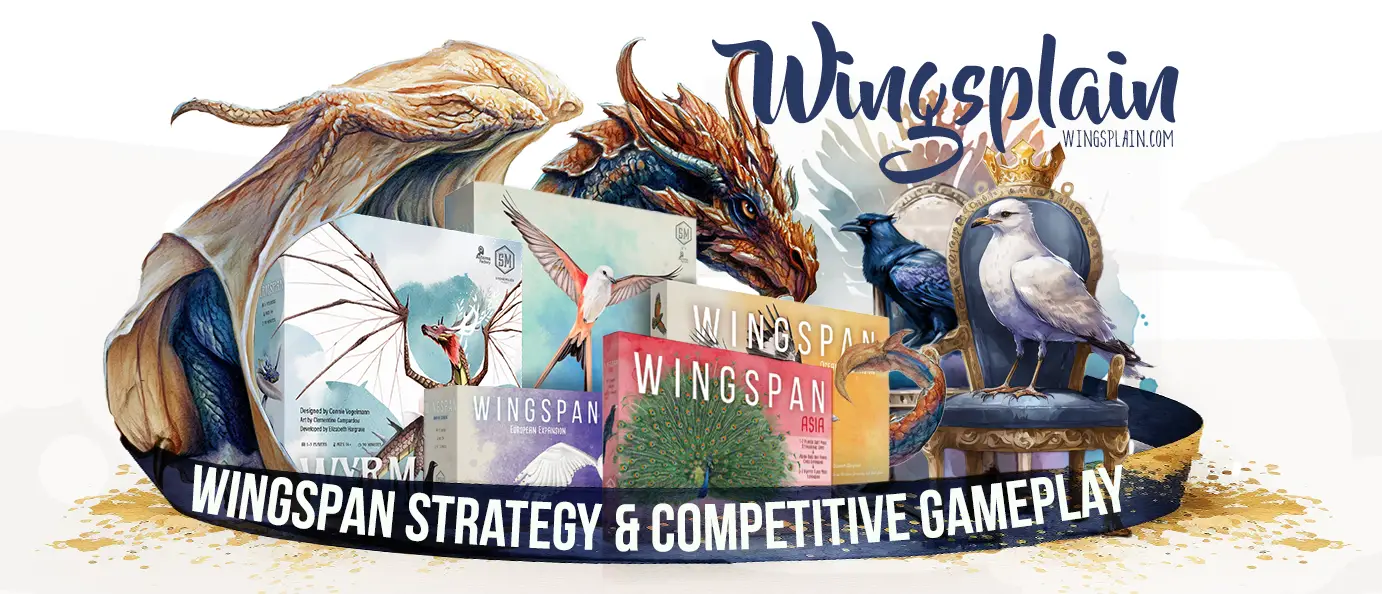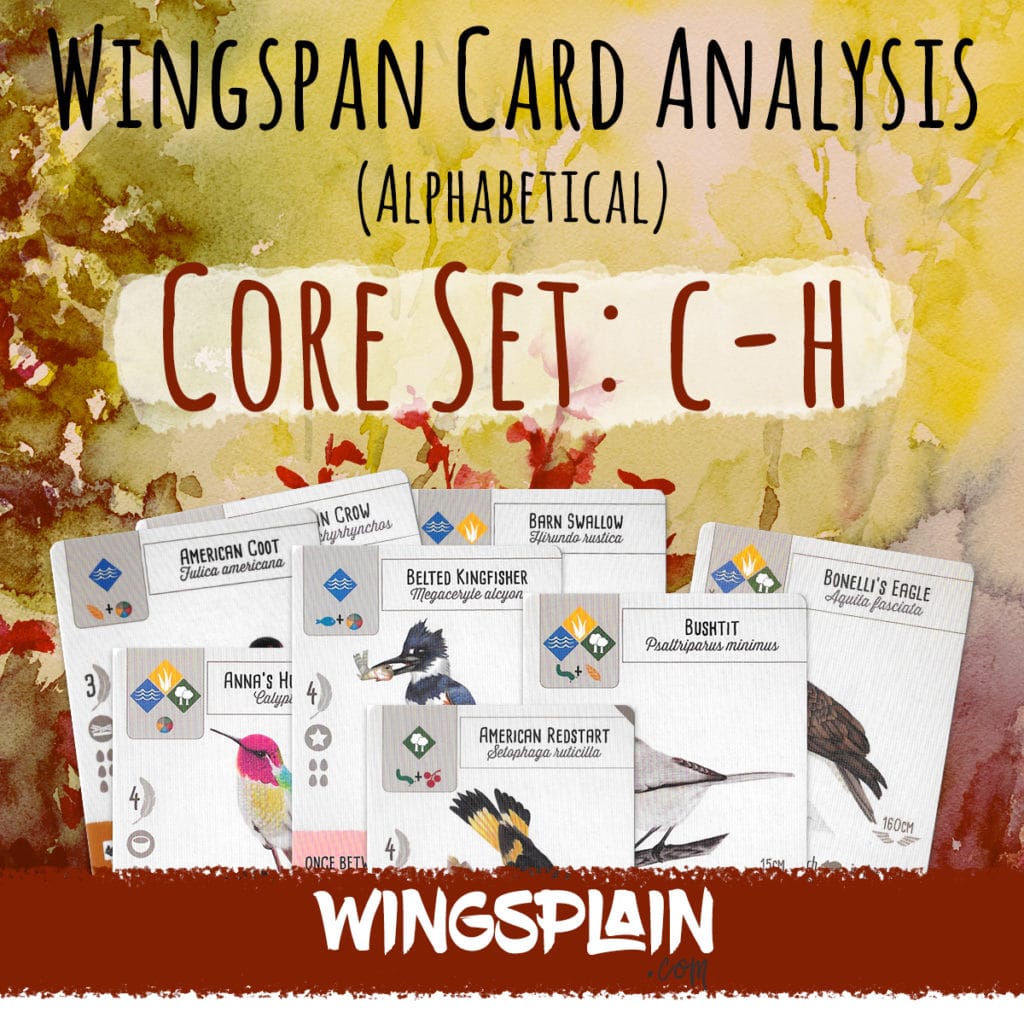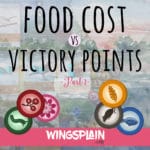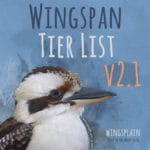Alphabetical Card Analysis is a series of posts that break down the good and the bad of each Wingspan card in a succinct manner. This second post includes the cards that begin with C through H from the Core Set plus the Swift Start Pack.
Wingspan Cards Core Set: C
California Condor
The cheapest bonus card bird at zero food cost, but it pays a high cost in other terms. At one victory point and a one egg nest, its power is risky, and its rate of return is low for the cost of an action cube. It doesn’t make up for drawbacks with impressive general qualities or great interactions with bonus cards itself. I generally wouldn’t play this bird unless I was desperate for a specific bonus card.
California Quail
Classic Quail Archetype. It can lay eggs from the forest, and it has the nest size to be effective at it. The three-food cost shouldn’t be much of a problem for a Forest engine. Three victory points are icing on the cake.
Canada Goose
Classic “discard one food to tuck two cards” archetype. If this Wingspan Card has direct seed support, it can generate a lot of points. Bird counter adds two more points to this bird. On its own, it is mediocre.
Canvasback
Moderate and flexible food cost. Good early game card draw acceleration, especially on the Oceania Expansion mat. It can be a solid early-game egg bank with its four-egg star nest. Omnivore Specialist adds two more points to it. Single Card Spotlight: Canvasback
Carolina Chickadee
Cheap and flexible food caching bird. This archetype of bird needs to be played early and leaned on often to carry its own weight.
Carolina Wren
Great early game card-draw accelerator. Cheap and flexible food cost. It’s useful after its power is spent since it is a great egg bank. It can be used to snipe good cards out of the bird tray at the start of the game.
Cassin’s Finch
Classic bonus card bird. Historian adds two points.
Cassin’s Sparrow
It’s restricted to the Grasslands and overpriced compared to other birds of this archetype. Despite this, its power is still useful by virtue of laying eggs on any bird.
Cedar Waxwing
It is hard to support because it can’t be played in the Wetlands, impacting its consistency and general usefulness. Bird Counter adds two points to this play.
Cerulean Warbler
Classic bonus card bird.
Chestnut-Collared Longspur
Another classic bonus card bird. This one is of the archetype that costs three food, is worth a bit more victory points, and can hold a couple more eggs.
Chihuahuan Raven
Restricted to the Grasslands, but that doesn’t impact this bird’s effectiveness since it wants to live there any way to fuel its power. Falls under the umbrella of Rodentologist, Large Bird Specialist, and Platform Builder along with predator birds. Omnivore Specialist adds two more points to it as well. It’s a good point bomb with the right bonus card. Considered to be one of the most powerful cards in the game, spurring the implementation of various Wingspan house rules to put it in check. Its power continues to impact the metagame by allowing Egg Spam strategies to generate food and victory points (through eggs) at the same time, ignoring the Forest altogether. It became even more powerful with the Oceania Expansion and the introduction of nectar. When paired with Franklin’s Gull or Killdeer in the Grasslands, it can be devastating to your opponents. Read more: The Power 4 Cards in Wingspan and Chihuahuan Raven and Common Raven Cards
Chimney Swift
Classic migrator. It qualifies for a large number of round bonuses, which is a plus for the migrating archetype. Still, despite its star nest, its egg capacity is too low for it to make much of an impact. Food Web Expert makes it worth two more points, but that isn’t enough to rescue this bird from mediocrity.
Chipping Sparrow
Great egg spammer. One of the best ways to lay eggs from the Forest. Cheap and effective. Allows you to lay eggs on any bird.
Clark’s Grebe
Five victory points for the cost of one food is this bird’s claim to fame (great efficiency). It becomes an amazing point bomb with Historian. Its two-egg star nest is an extra bonus. Its power lets you see more cards, but you just break even on the exchange.
Clark’s Nutcracker
A good point bomb with Omnivore Specialist or Historian. Its power is conditional yet flexible.
Common Grackle
Classic Tuck/Lay archetype. Omnivore Specialist and Bird Counter add two points each. Tri-habitat so it can go in the Wetlands to fuel its power.
Common Loon
A good point bomb under Omnivore Specialist. Its power is conditional and can be difficult to use effectively.
Common Merganser
A good point bomb under Omnivore Specialist or Falconer. A four-egg nest is good. Its power is among the least consistent in the game.
Common Nighthawk
Classic migrator. Food Web Expert makes it worth two more points, but that isn’t enough to rescue this bird from mediocrity.
Common Raven
Tri-Habitat increases your options if you can supply it with eggs in the Forest or Wetlands, but it generally wants to live in the Grasslands to consistently fuel its power. Falls under the umbrella of Rodentologist, Large Bird Specialist, and Platform Builder along with predator birds. Omnivore Specialist adds two more points to it as well. It’s a good point bomb with the right bonus card. Considered to be one of the most powerful cards in the game, spurring the implementation of various house rules to put it in check. Its power continues to impact the metagame by allowing Egg Spam strategies to generate food and victory points (through eggs) at the same time, ignoring the Forest altogether. It became even more powerful with the Oceania Expansion and the introduction of nectar. When paired with Franklin’s Gull or Killdeer in the Grasslands, it can be devastating to your opponents.
Common Yellowthroat
One of the best ways in the game to draw a large volume of cards early, especially on the Oceania Expansion mat. Great early game card accelerator. Decent egg bank with its four-egg nest. Food Web Expert adds two points.
Cooper’s Hawk
Like most predators, it falls under the umbrella of Rodentologist, Falconer, Large Bird Specialist, and Platform builder. Historian adds another two points. The consistency of its power is about 69%. Makes a great point bomb with the right bonus card(s).
Wingspan Cards Core Set: D
Dark-Eyed Junco
A mini Maned Duck in effect, but it can’t go in the Wetlands. Its power is hard to support consistently because of this. Bird counter adds two points.
Dickcissel
An overpriced Tuck/Lay bird that can’t go into the Wetlands to fuel its power. It’s hard to support effectively as a result. Bird counter adds two points.
Double-Crested Cormorant
Classic “discard one food to tuck two cards” archetype. If this Wingspan Card has direct fish support, it can generate a lot of points. Bird Counter and Omnivore Specialist add two points each to this bird.
Downy Woodpecker
Classic “play another bird” archetype. Cheap, flexible food cost. Setting this up can be resource-intensive but is generally worth it when you improve board position or drop point bombs.
Wingspan Cards Core Set: E
Eastern Bluebird
Classic “play another bird” archetype. A moderate food cost gets you four victory points and a five-egg nest, making it a great egg bank. Setting this up can be resource-intensive, but it is generally worth it when you improve board position or drop point bombs.
Eastern Kingbird
This bird’s pink power doesn’t make much of an impact, and its general qualities are poor. Bonus cards can’t save this one from mediocrity.
Eastern Phoebe
This bird is a good early game food accelerator with a nice four-egg star nest. Cheap, flexible food cost and Tri-Habitat, allowing you to produce food from the Grasslands and Wetlands. Its drawback is that it gives invertebrates to all players.
Eastern Screech Owl
Like most predators, it qualifies for both Rodentologist and Falconer, adding two points each. Makes a very efficient point bomb with those bonus cards. Its power is among the least consistent in the game.
Wingspan Cards Core Set: F
Ferruginous Hawk
Like most predators, this bird falls under the umbrella of Rodentologist, Falconer, Larger Bird Specialist, and Platform Builder. This bird makes a good point bomb with the right bonus cards. Its power is among the least consistent in the game.
Fish Crow
Moderate and flexible food cost. Its power is half as effective as a Raven which makes a noticeable difference. I have found that it can still be an effective source of food in the Grasslands, especially when paired with a Hummingbird. Omnivore Specialist adds two points which makes it a good point bomb.
Forster’s Tern
Cheap and flexible food cost for a four-point bird with a two-egg star nest, which is decent. Its power lets you see more cards, but you just break even on the exchange.
Franklin’s Gull
Moderate and flexible food cost. Its two-egg star nest is small but handy. Historian and Omnivore Specialist add two points each to this bird. It can live in the Wetlands, but it wants to live in the Grasslands, where it gets the fuel for its power. Considered to be one of the most powerful cards in the game, it continues to impact the metagame by allowing Egg Spam strategies to generate cards and victory points (through eggs) at the same time, ignoring the Wetlands altogether. When paired with Chihuahuan Raven or Common Raven in the Grasslands, it can be devastating to your opponents. Read more: Franklin’s Gull & Killdeer
Wingspan Cards Core Set: G
Golden Eagle
Like most predators, this bird falls under the umbrella of Rodentologist, Falconer, Larger Bird Specialist, and Platform Builder. This is an expensive point bomb that can generate extra victory points with its power, which is at the top end of its archetype for consistency (80%).
Grasshopper Sparrow
Being able to lay eggs on any bird saves this bird from mediocrity. Its general qualities are poor. Being restricted to the Grasslands means it’s just helping to bolster egg spam strategies.
Gray Catbird
The expensive repeat bird. This bird’s power gives you the choice of triggering your best power an extra time, which can be amazing.
Great Blue Heron
A beefier “play another bird” bird with no other special qualities. Setting this up can be resource-intensive but is generally worth it when you improve board position or drop point bombs.
Great Crested Flycatcher
It can be a decent food accelerator. Its power is conditional on a common food type in the birdfeeder. Five victory points with a three-egg nest for a moderate food cost make this a solid middle-of-the-road bird.
Great Egret
The beefiest “play another bird” bird. Rodentologist makes it even beefier by tacking on two points. This is one of seven birds that are worth seven-plus victory points that can hold three or more eggs. Setting this up can be resource-intensive but is generally worth it when you improve board position or drop point bombs.
Great Horned Owl
Like most predators, this bird falls under the umbrella of Rodentologist, Falconer, Larger Bird Specialist, and Platform Builder. This is an expensive point bomb that can generate extra victory points with its power, which is at the top end of its archetype for consistency (80%).
Greater Prairie-Chicken
Another classic bonus card bird. This one is of the archetype that costs three food, is worth a bit more victory points, and can hold a couple more eggs.
Greater Roadrunner
Like most predators, this bird falls under the umbrella of Rodentologist, Falconer, and Platform Builder. Omnivore Specialist likes this bird as well. This is an expensive point bomb that can generate extra victory points with its power, which is at the bottom end of its archetype for consistency (56%).
Green Heron
This bird has a unique food filtering power that could be pretty useful under the right circumstances. If playing with the Oceania Expansion, you can turn any one food into nectar. It has a cheap and flexible food cost and has some good value at that cost being worth four victory points and having a three-egg nest.
Wingspan Cards Core Set: H
Hermit Thrush
An expensive point bomb with a two-egg star nest. You’re probably not going to be using this power very often. In the best-case scenario, all of your opponents will need one more forest bird than you to make this worth your while. It might still be worth it if you at least tie for the fewest forest birds.
Hooded Merganser
An interesting spin on the repeat archetype. It’s restricted to the Wetlands and can only repeat predators. This card stands to increase in value with each expansion as more Wetland predators are released. At a moderate food cost, this might not be a bad play on its own since it is worth five victory points and has a four-egg nest.
Hooded Warbler
This bird’s claim to fame is being a seven-point, three egg nest bird that only costs two food. As far as big point birds currently go, this is cheap. Read more: Hidden Value in Wingspan
Horned Lark
This bird’s pink power can be difficult to use since it is conditional, your opponent controls it, and you tuck from your hand instead of the deck. At a moderate food cost, this might not be a bad play on its own since it is worth five victory points and has a four-egg nest.
House Finch
A tri-habitat tuck/draw bird with a moderate food cost and a large six-egg nest. Makes a great egg bank, even if you are not adopting a tucking strategy.
House Wren
This “play another bird” bird has the flexibility of being dual habitat. It makes a great egg bank with its large five egg nest. Setting this up can be resource-intensive but is generally worth it when you improve board position or drop point bombs.
For more, see Alphabetical Card Analysis: Core Set A-B
Want More Wingspan Card Breakdowns?
Follow our blog for instant email notification when the next batch is published! You’ll find the subscription form in the right sidebar. —>
Please leave your comments below. We welcome constructive comments on all of our posts and enjoy talking about Wingspan with the community.



